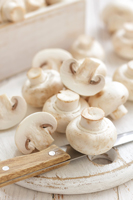Chamomile (Matricaria recutita) is one of the best known and most versatile of medicinal plants. While it is indigenous to various parts of central and southern Europe (Germany, Hungary, Slovakia, Italy, and Croatia), and northwestern Asia, chamomile is now widely cultivated in Australia, Argentina, the United States, northern Africa, and Egypt.
Chamomile, a member of the daisy family Asteraceae, has prominent white flowers with conical, golden centers. Chamomile derives its name from two Greek words: chamos (ground), and melos (apple), that refer to its low growing habit (grows only eight to 16 inches in height) and its apple-scented feathery leaves.
For many centuries chamomile has been used to treat an upset stomach, heal cuts and sores, reduce inflammations, and induce sleep. It was an important drug in ancient Egyptian, Greek, and Roman medicines. Its versatility is reflected in the fact that today Germans often describe chamomile as alles zutraut–capable of anything.
Chamomile is marketed in Europe for a wide variety of ailments, and it is listed as an official drug in the pharmacopeias of over two dozen countries. In the United States chamomile is now one of the most commonly used herbal tea ingredients.
Multiuses
The active properties of chamomile reside in the fresh or dried flower heads (capitulums). Preparations made from chamomile flowers can be used externally in a variety of ways. For example, it can be used in mouth gargles and rinses to treat inflammations of the mouth, throat, and gums; as an aromatic tea to stimulate the appetite and digestion; as a vapor inhalant to treat bronchial irritations; in creams or lotions to treat wounds and various skin irritations and bacterial infections; and as an additive for sitz baths and rinses to treat hemorrhoids and genital inflammations.
Chamomile preparations are ideal for treating the sensitive skin of young children who have diaper rash or other inflammatory skin conditions. A chamomile ointment has been shown to be as effective as hydrocortisone, and more effective than typical nonsteroidal anti-inflammatory agents, for the treatment of inflammatory dermatitis.
An Inside Job!
Chamomile can also be used internally. Chamomile tea can be used to treat digestive disturbances, gastrointestinal spasms, inflammatory disease of the gastrointestinal tract, and to treat coughs and colds, fevers and bronchitis. A cup of freshly made chamomile tea may be drunk to ease stomach and intestinal disturbances. The usual dosage for an infusion is about three grams of the flower heads in one half cup of hot water, taken three to four times a day between meals. Chamomile tea has also been used as a mild sedative to induce sleep, especially in children. Chamomile is known to contain a variety of active flavonoids and coumarins, as well as a volatile oil that is rich in terpenoids such as alpha-bisabolol, bisabolol oxides, and chamazulene. These constituents provide the anti-inflammatory, antispasmodic, and antibacterial activity of chamomile.
Purity and Safety Issues
Unfortunately, chamomile and chamomile oil are relatively easy to adulterate with cheaper inactive plant material. To assure a high-quality product, chamomile should be purchased from reliable commercial sources.
No health hazards or side effects are known with its use. It appears safe to use during pregnancy and while breast feeding. There are no known interactions with other drugs or herbs. People allergic to flowers in the daisy family, such as ragweed, asters, and chrysanthemums, should exercise caution with chamomile teas, since there is a risk of allergic reactions. Otherwise, the use of chamomile is perfectly safe and efficacious.
Remember: Herbal products and dietary supplements can have pharmacological effects, may produce adverse reactions in some people, and could interact with over-the-counter and prescription medications you may take. Discuss with your physician your decision to use any herbal product. Anything mentioned in this article is not intended to diagnose, prescribe, or treat any ailment.
Winston J. Craig, Ph.D., R.D., is a professor of nutrition at Andrews University, Berrien Springs, Michigan.




